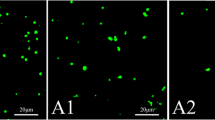Abstract
Candida albicans has frequently shown resistance to azoles, the commonly used antifungal drugs. Efg1 has dual role under normoxia and hypoxia supporting infection. It is the major regulator of morphogenesis in C. albicans requisite for its pathogenesis. Targeting this protein is expected to render Candida ineffective to undergo filamentation causing virulence. Further the glyoxylate pathway supports the stress resistance and pathogenesis. In the present study an in silico approach and in vitro validation has been performed to find the potential role of polyphenols in controlling hyphal growth in C. albicans. The aspect of changes biome which may provide required niche to the pathogen has been checked which certainly opens the doors towards safe natural polyphenol-based drugs as potent antifungals.




















Similar content being viewed by others
References
Borman AM, Szekely A, Johnson EM (2009) Comparative pathogenicity of United Kingdom isolates of the emerging pathogen Candida auris and other key pathogenic Candida species. mSphere 1(4):4–6
Bowers KJ et al (2006) Molecular dynamics-Scalable algorithms for molecular dynamics simulations on commodity clusters. In: Proceedings of the 2006 ACM/IEEE conference on Supercomputing–SC’06, p 84
Dixon SL et al (2006) PHASE: a new engine for pharmacophore perception, 3D QSAR model development, and 3D database screening. J Comput Aided Mol Des 20(10–11):647–671
Fanning S, Mitchell AP (2012) Fungal biofilms. PLoS Pathog 8(4):e1002585
Friesner RA et al (2006) Extra precision glide: docking and scoring incorporating a model of hydrophobic enclosure for protein-ligand complexes. J Med Chem 49(21):6177–6196
Halgren TA (2009) Identifying and characterizing binding sites and assessing druggability. J Chem Inf Model 49(2):377–389
Leng P, Brown AJP (2001) Efg1, a morphogenetic regulator in Candida albicans is a sequence specific DNA binding protein. J Bacteriol 183(13):4090–4093
Shrivash MK et al (2018) Attenuation of pathogenicity in Candida albicans by application of polyphenols. J Microb Biochem Technol 10(2):27–39
Mayer FL, Wilson D, Hube B (2013) Candida albicans pathogenicity mechanisms. Virulence 4(2):119–128
Mishra S et al (2018) Integrated pathways of Candida albicans revealing potential targets and key factors accountable for pathogenicity. Proc Natl Acad Sci India Sect B 89:187–218
Tao L, Zhang Y, Fan S, Nobile CJ, Guan G et al (2017) Integration of the tricarboxylic acid (TCA) cycle with cAMP signaling and Sfl2 pathways in the regulation of CO2 sensing and hyphal development in Candida albicans. PLoS Genet 13:e1006949
Mishra S, Singh S, Misra K (2017) Restraining pathogenicity in Candida albicans by taxifolin as an inhibitor of Ras1-pka pathway. Mycopathologia 182(11–12):953–965
Ross JA, Kasum CM (2002) Dietary flavonoids: bioavailability, metabolic effects, and safety. Annu Rev Nutr 22(1):19–34
Sogabe S, Masubuchi M, Sakata K, Fukami TA, Morikami K, Shiratori Y, Ebiike H, Kawasaki K, Aoki Y, Shimma N, D’Arcy A, Winkler FK, Banner DW, Ohtsuka T (2002) Crystal structures of Candida albicans N-myristoyltransferase with two distinct inhibitors. Chem Biol 9:1119–1128
Madhavi Sastry G et al (2013) Protein and ligand preparation: parameters, protocols, and influence on virtual screening enrichments. J Comput Aided Mol Des 27(3):221–234
Irwin JJ, Shoichet BK (2005) ZINC—a free database of commercially available compounds for virtual screening. J Chem Inf Model 45:177–182
Sastry GM, Adzhigirey MT, Day R, Sherman W (2013) Protein and ligand preparation: parameters, protocols, and influence on virtual screening enrichments. J Comput Aided Mol Des 27(3):221–234
Volkamer A, Kuhn D, Rippmann F, Rarey M (2012) Dogsitescorer: a web server for automatic binding site prediction, analysis and drug-gability assessment”. Bioinformatics 28(15):2074–2075
Willins DA, Morales AJ, Cottarel G, Alberti-Segui C (2007) Identification of candida cell surface proteins and their uses. US Patent 7,241,613
Wayne PA (2008) Clinical and laboratory standards institute, reference method for broth dilution antifungal Susceptibility testing of yeast, approved standard-third edition. CLSI document M27-A3
Gillum AM, Tsay EY, Kirsch DR (1984) Isolation of the Candida albicans gene for orotidine-5′-phosphate decarboxylase by complementation of Saccharomyces cerevisiae ura3 and Escherichia coli pyrF mutations. Mol Genet Genom 198:179–182
Benzie IF, Strain JJ (1996) The ferric reducing ability of plasma (frap) as a measure of antioxidant power: the frap assay. Anal Biochem 239(1):70–76
Benzie IF, Strain J (1999) Ferric reducing/antioxidant power assay: direct measure of total antioxidant activity of biological fluids and modified version for simultaneous measurement of total antioxidant power and ascorbic acid concentration. Methods Enzymol 299:15–27
Stockert JC, Blázquez-Castro A, Cañete M, Horobin RW, Villanueva A (2012) MTT assay for cell viability: intracellular localization of the formazan product is in lipid droplets. Acta Histochem 114:785–796. https://doi.org/10.1016/j.acthis.2012.01.006
Author information
Authors and Affiliations
Corresponding author
Additional information
Publisher's Note
Springer Nature remains neutral with regard to jurisdictional claims in published maps and institutional affiliations.
Electronic supplementary material
Below is the link to the electronic supplementary material.
Rights and permissions
About this article
Cite this article
Mishra, S., Rastogi, S.K., Singh, S. et al. Controlling pathogenesis in Candida albicans by targeting Efg1 and Glyoxylate pathway through naturally occurring polyphenols. Mol Biol Rep 46, 5805–5820 (2019). https://doi.org/10.1007/s11033-019-05014-z
Received:
Accepted:
Published:
Issue Date:
DOI: https://doi.org/10.1007/s11033-019-05014-z




